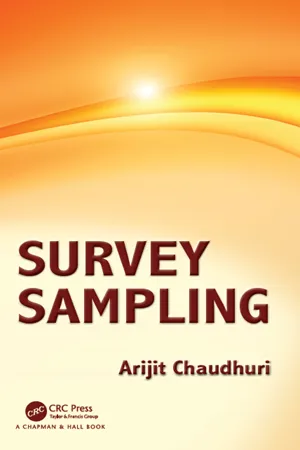
This is a test
- 218 pages
- English
- ePUB (mobile friendly)
- Available on iOS & Android
eBook - ePub
Survey Sampling
Book details
Book preview
Table of contents
Citations
About This Book
This venture aspires to be a mix of a textbook at the undergraduate and postgraduate levels and a monograph to catch the attention of researchers in theoretical and practical aspects of survey sampling at diverse levels demanding a comprehensive review of what useful materials have preceded, with an eye to what beacons to the depth of the imminent future.
Frequently asked questions
At the moment all of our mobile-responsive ePub books are available to download via the app. Most of our PDFs are also available to download and we're working on making the final remaining ones downloadable now. Learn more here.
Both plans give you full access to the library and all of Perlego’s features. The only differences are the price and subscription period: With the annual plan you’ll save around 30% compared to 12 months on the monthly plan.
We are an online textbook subscription service, where you can get access to an entire online library for less than the price of a single book per month. With over 1 million books across 1000+ topics, we’ve got you covered! Learn more here.
Look out for the read-aloud symbol on your next book to see if you can listen to it. The read-aloud tool reads text aloud for you, highlighting the text as it is being read. You can pause it, speed it up and slow it down. Learn more here.
Yes, you can access Survey Sampling by Arijit Chaudhuri in PDF and/or ePUB format, as well as other popular books in Mathématiques & Probabilités et statistiques. We have over one million books available in our catalogue for you to explore.
Information
Chapter 1: Certain Essential Preliminaries
1.0 Summary
In order to go ahead formally certain terms and notations are introduced first. The principal problem is concisely stated. A few alternative routes to follow in quest of solutions are earmarked. A few classical results and approaches are narrated.
1.1 Concepts of Population, Sample, Survey, Census, Sampling: Design and Schemes, Estimator and Strategy
To cover a situation at the outset we attend to a totality of elements.
Let U = (1, …, i, …, N) denote a ‘finite’ population, which is an entire collection of known concrete and tangible objects which are distinct and identifiable as separate and attached tags or labels 1, 2, …, i, …, N for their respective discernibility. For example, we may be concerned with saying something about each of the 51 states and the capital territory of USA named Arizona, Utah, California, Virginia etc. which are labelled respectively as 1, 2, 3, 4 etc. for simplicity. Here N is a known number. We may intend to say something about the various blocks of buildings scattered in a big locality earmarked near Trafalgar Square in London, UK. Instead of giving them names we may label them conventionally and assign them distinct numbers to label them to separately refer to them in order to say something about them. We refer to U, the totality as a ‘Population’ or sometimes also as a ‘Universe’ and the elements labeled 1, 2, …, i, …, N may be called its elements or units or individuals.
In situations when we study and examine each of these units with a view to saying something about the entire population of all the N elements, then we say that we are ...
Table of contents
- Cover
- Half Title
- Title Page
- Copyright Page
- Dedication
- Table of Contents
- Acknowledgment
- About the author
- Preface
- My plea for this composition and my target readership
- Introduction
- Chapter 1: Certain Essential Preliminaries
- Chapter 2: Further Essentials for Unstratified Uni-Stage Cases
- Chapter 3: More in Design-Based Sampling
- Chapter 4: Super-Population Modeling and Its Various Uses
- Chapter 5: Indirect Questioning in Sensitive Surveys
- Chapter 6: Adaptive and Network Sampling
- Chapter 7: Inadequate and Multiple Frames
- Chapter 8: Analytic Studies
- Chapter 9: Case Studies
- Chapter 10: Lessons and Exercises
- Chapter 11: Reviews
- Chapter 12: An Appraisal
- References
- Index